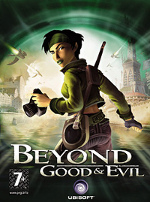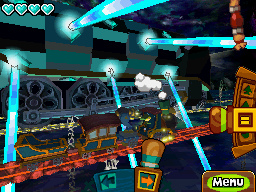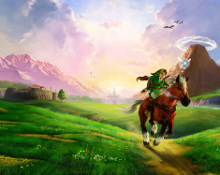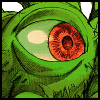Zelda Overworlds: Learning From Other Series
Posted on August 17 2012 by Axle D. Wilder
 In my old article, Overworlds: The Land Between, I took the time to define the personal names I have for four styles of overworld commonly seen in Zelda. The wilderness is a wild and dangerous area where you are left on your own, while the map is either a miniaturized representation of the world or little more than a menu. But it’s the hub and transportation overworlds that I will be focusing on in this article, for I believe that the execution of these overworld concepts has generally been weak in the Zelda series.
In my old article, Overworlds: The Land Between, I took the time to define the personal names I have for four styles of overworld commonly seen in Zelda. The wilderness is a wild and dangerous area where you are left on your own, while the map is either a miniaturized representation of the world or little more than a menu. But it’s the hub and transportation overworlds that I will be focusing on in this article, for I believe that the execution of these overworld concepts has generally been weak in the Zelda series.
In the aforementioned article I discussed why I felt that the wilderness overworlds were the most natural fit for the Zelda series, but whether that’s true or not, the other styles of overworld should be able to work when well-executed; this article is not about bashing Zelda and talking about why half of its overworlds suck, but an in-depth look at what I believe to be flaws and an examination on how they can be improved. To do this, I will be looking to other series that have executed these overworlds better than any Zelda game has.
So first let’s begin with the most talked about style: The transportation overworlds, where the gameplay actually changes into something else while you travel, typically due to riding a vehicle or mount. There are two games in particular that use this style of overworld that I think have outperformed Zelda’s use of it. These are Beyond Good & Evil and Kingdom Hearts II.
Beyond Good & Evil is an adventure game, similar in some ways to Zelda and different in others, where you journey across the game’s world and talk to characters in order to uncover a conspiracy. Its areas are traversed on foot, but the overworld itself is traversed via hovercraft for most of the game. Moving over water and land, this hovercraft can take you across the sprawling world very quickly, and while there is travel time, it rarely exceeds three minutes. This game doesn’t allow you to walk from area to area, and instead sells the world’s size by having you traverse it in a vehicle, while cutting the travel time down to a minimum.
 The transportation overworlds of The Wind Waker, Phantom Hourglass, and Spirit Tracks all share one immense problem: The actual gameplay is not interesting. The best arguments in favor of The Wind Waker’s overworld typically praise its immersion and atmosphere, or talk about how much stuff there is to find on the sea. But I’ve never heard anyone defend the actual controls and functions of the boat itself as fun, and I certainly don’t enjoy them myself; the gameplay involved with the vehicles in all three games are time-consuming, involve little to no player input, and present no challenge or reward.
The transportation overworlds of The Wind Waker, Phantom Hourglass, and Spirit Tracks all share one immense problem: The actual gameplay is not interesting. The best arguments in favor of The Wind Waker’s overworld typically praise its immersion and atmosphere, or talk about how much stuff there is to find on the sea. But I’ve never heard anyone defend the actual controls and functions of the boat itself as fun, and I certainly don’t enjoy them myself; the gameplay involved with the vehicles in all three games are time-consuming, involve little to no player input, and present no challenge or reward.
Beyond Good & Evil on the other hand put a large amount of effort into its hovercraft, and uses the same vehicle with the same controls for multiple racing mini-games, boss battles, and even exploring some of the other areas besides the overworld; one of the game’s later dungeons involves a network of waterways connecting its on-foot portions that must be crossed in the hovercraft. While both The Wind Waker and Phantom Hourglass have boss battles on the overworld, most of them are dull or are spent stationary, robbing it of the full overworld experience. A notable exception is the train bosses in Spirit Tracks, however, and despite that game’s transportation flaws, I will acknowledge these as high points.
What Zelda should learn from Beyond Good & Evil is that you should use the presence of a faster transportation method to sell the world and its size, it should not take long to traverse this overworld, and the gameplay you find yourself in while traveling should be fun on its own and just as well-designed as the rest of the game. Without a reason for the player to want to pilot their mode of transport, the overworld should just stick to the gameplay that’s fun.
Then you have Kingdom Hearts with its buildable Gummi Ships, used to fly between the game’s worlds in rail shooter levels. The original Kingdom Hearts had this, but it was far more poorly conceived than any transportation in Zelda has ever been, and is a frustrating chore not because of game design but because of its gameplay; it’s simply not fun to fly the Gummi Ship, and you’re forced to endure it repeatedly just to get to other areas or return to places you’ve been. Though it’s worse in Kingdom Hearts, this same issue is pravelent in Zelda, affecting The Wind Waker, Phantom Hourglass, and worst of all, Spirit Tracks, where you have to spend a lot of time following set tracks and winding around to your destination.
 Kingdom Hearts II improved on this immensely. The flight sections were given a total facelift and made into an almost stand-alone mini-game. These rail-shooter sections resemble something you might see in Star Fox, and have a hefty number of levels with many secret treasures to find, bonuses for high rankings, and three missions per level, each with their own criteria for increasing your rank and their own set of rank rewards and treasures. Hours can be spent playing the Gummi levels, and that’s without diving into the extremely elaborate ship-building, where you can customize your ship down to its exact shape and color scheme out of the blocks, weapons and power-ups acquired in the Gummi levels themselves. Since completing the levels is the only thing that awards you new ship parts, it truly is a self-contained game that has its own rewards for playing.
Kingdom Hearts II improved on this immensely. The flight sections were given a total facelift and made into an almost stand-alone mini-game. These rail-shooter sections resemble something you might see in Star Fox, and have a hefty number of levels with many secret treasures to find, bonuses for high rankings, and three missions per level, each with their own criteria for increasing your rank and their own set of rank rewards and treasures. Hours can be spent playing the Gummi levels, and that’s without diving into the extremely elaborate ship-building, where you can customize your ship down to its exact shape and color scheme out of the blocks, weapons and power-ups acquired in the Gummi levels themselves. Since completing the levels is the only thing that awards you new ship parts, it truly is a self-contained game that has its own rewards for playing.
Better yet, little about the Gummi levels in Kingdom Hearts II is forced on the player. Levels must only be completed once to unlock the area they block, never forcing you to click on them on the world map again if you don’t want to. And if you don’t want to build your own ship, they give you plenty of pre-built ships that you can use, with many to unlock.
The nature of Kingdom Hearts II’s overworld should actually seem familiar to those who have played Spirit Tracks. Spirit Tracks recycled the concept behind the Temple of the Ocean King area — a central dungeon that must be revisited many times and explored bit by bit — and revised it so you only have to do each floor once and can skip it later, but can return to find new secrets with your new items. That is exactly like the Gummi levels in Kingdom Hearts II, and makes you wonder why they didn’t do the same with the overworld. You already have to draw your routes to icons on a map to travel; Spirit Tracks would have been much improved if, like Kingdom Hearts II, the routes were linear stages that needed to be played once to unlock the area the route blocks, and then never needed to be visited again unless you wanted to try for a better score. Indeed, a linear rail-shooter on the train would have been an improvement, allowing it to function similarly to the Demon Train battle near the end of the game; shoot a variety of enemies while switching tracks to avoid hazards and find secrets or perhaps hidden switches to unlock new routes. Since this is Zelda, perhaps they could have one-upped Kingdom Hearts II by adding levels that lead to secret areas, similar to how Spirit Tracks had you unlock new sections of track leading to hidden stations.
 Replaying Kingdom Hearts II recently, I really realized that it has my favorite transportation overworld from any game by far, and there’s a lot Nintendo should learn from it: Make the overworld’s gameplay into a game of its own, with its own rewards, or even rewards that affect the rest of the game. Make them want to play it on its own and see what it has to offer, but never force them to do so more than absolutely necessary. Zelda is an adventure game, and its best titles allow the player some leeway to go and check something else out if they’re not having fun, or come back more prepared, and this principle should persist even in a game with a transportation overworld.
Replaying Kingdom Hearts II recently, I really realized that it has my favorite transportation overworld from any game by far, and there’s a lot Nintendo should learn from it: Make the overworld’s gameplay into a game of its own, with its own rewards, or even rewards that affect the rest of the game. Make them want to play it on its own and see what it has to offer, but never force them to do so more than absolutely necessary. Zelda is an adventure game, and its best titles allow the player some leeway to go and check something else out if they’re not having fun, or come back more prepared, and this principle should persist even in a game with a transportation overworld.
Epona also functions like the vehicles found in transportation overworlds — she marks a change in gameplay in order to travel quickly — so she qualifies as a mode of transportation as well. I did an entire segment for Zelda Dungeon’s podcast discussing the flaws present in Epona’s design throughout the series, and in that segment I suggested Zelda take some hints from Shadow of the Colossus. While Shadow of the Colossus also has drawbacks in its overworld, Zelda can still learn from it and ideally combine the two designs.
Where Shadow of the Colossus excels at the horseback travel is the horse’s constant usefulness and necessity, along with the design of the landscape itself. The game’s horse, Agro, has a degree of intelligence to lead him from running into obstacles, though the pathing could use further improvement and, ideally, could be tweaked to allow the horse to travel both open and dense environments without any slowdown, which would solve one of the greatest problems with Epona in the Zelda series: In most games with Epona, the overworld is very open and not very complex, because she couldn’t work in a dense, content-packed overworld. With proper pathing and intelligence for the horse, this problem would become irrelevant, and it would turn the horse into a way of making expansive areas like fields easily traversable while still making tight areas just as accessible, ideally in an overworld that would balance both environment types.
Furthermore, with beautiful world design like that of Shadow of the Colossus, the landscape itself would serve as a reason to travel, which is something Zelda has never quite pulled off with its barren fields, excessive oceans, and empty skies. Again, there has to be a reason to want to use the horse if it’s going to be in the game at all.

As I said in the begining of this article, I also want to talk about hub overworlds, which are overworlds with central areas that branch off toward the other places in the game. This didn’t appear in the Zelda series until Ocarina of Time, which had the central Hyrule Field. Majora’s Mask and Skyward Sword also use variations on this, though they do it very differently. Majora’s Mask’s hub of Termina Field was much denser and filled with content while Hyrule Field was empty. It also had a central town that was constantly changing and crucial to the plot, and its branching areas were more than just corridors, actually serving as different locations or hubs of their own that needed to be explored. Skyward Sword executed this very similarly, except that its hub overworld was actually a transportation overworld in the form of the Sky, with another evolving main town, and several expansive areas in the form of the provinces below.
Majora’s Mask was an effective hub overworld, giving you a worthwhile location that had a lot of stuff to do, so returning to it never felt repetitive, but both Ocarina of Time and Skyward Sword suffered from problems because of their hub structure. In this case, Majora’s Mask actually serves as a proper example, but other games that typically get this right are actually 3D platformers, like Super Mario 64 and Super Mario Sunshine, and even the Banjo-Kazooie games.
All of those games offer evolving central areas, where either things will change constantly as the game progresses, or new paths will open. Often, these central areas are no less compelling than the main areas themselves, offering similar challenges — including puzzles and battles — and secrets to find. They serve as central levels (they truly play like the main levels) and constantly change in one way or another to prevent them from becoming stale. These are the same things Majora’s Mask excelled at: sameness, lots of content, and evolution.

Skyward Sword would seem to mimic the success of Majora’s Mask but also fell short of pulling it off right. Its hub consisted of the Sky and Skyloft. The flying in the game managed to be fun to do (for some people, anyway), but offered little to nothing in the way of rewards — it lacked content and compelling visuals — making it effectively pointless other than to get from point A to point B. It had the same problems as both the vehicle and horse based transportation overworlds, and also failed as a hub; it had very little content, and it did not evolve. Skyloft is said to evolve, but its changes are minor, spread far apart, and are rarely highly rewarding. Skyward Sword should have more closely followed the example of both better transportation overworlds, and better hub overworlds.
Alternatively, Skyward Sword could have also learned a little from Jade Empire, an action-RPG which offered a scrolling shooter mini-game for quick transportation from area to area. Though this was only available as a method of quick transportation after the end of the main story, it shows an example of where Skyward Sword could have turned its simple overworld into an advantage: If Skyward Sword’s land sections had been interconnected, and the surface had been meant to be explored in full without the back-and-forth between the Sky and the Surface, then the Sky would have drastically increased in usefulness and importance, becoming both at once a method of quicker transportation and a refuge from the main game area. If it hadn’t been treated as the main overworld area, the Sky wouldn’t have been as flawed for being so empty.
The overall problem with these flawed overworlds is the fact that there winds up being little reason why they should exist. Without compelling content or rewards, fun gameplay, game design that make them fruitful in other ways, or really any reason to enjoy or benefit from the travel itself, there’s no reason the travel should be a part of the game. There are definitely valid arguments in favor of the journey itself being a worthwhile experience, but I don’t find this to be a compelling defense of these overworlds as they are so barren and uninteresting; with nothing to do or to see while traveling, even the journey itself becomes useless because there’s nothing about it to enjoy. These overworlds do have redeeming qualities, but overall they end up wasting the player’s time more than they benefit them, and Nintendo should learn how to improve these overworlds to be more worthwhile in themselves… or else do away with them entirely.
 That does tend to be Nintendo’s weak point, though: Learning from other companies. It’s something Nintendo needs to overcome. They need to shed their pride enough to accept and implement successful ideas and designs from other series when necessary. I believe they can and should do this, so they can improve their great series even more. Again, these overworlds have redeeming qualities and I do manage to enjoy them from time to time, but they come dangerously close to being complete wastes of time, and there’s no reason for that in such an excellent series. Here’s hoping that, moving forward, Nintendo starts learning from others.
That does tend to be Nintendo’s weak point, though: Learning from other companies. It’s something Nintendo needs to overcome. They need to shed their pride enough to accept and implement successful ideas and designs from other series when necessary. I believe they can and should do this, so they can improve their great series even more. Again, these overworlds have redeeming qualities and I do manage to enjoy them from time to time, but they come dangerously close to being complete wastes of time, and there’s no reason for that in such an excellent series. Here’s hoping that, moving forward, Nintendo starts learning from others.




